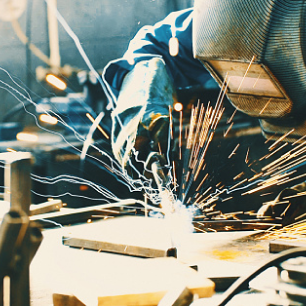Jump to:
Understanding Weld Cracking
Cracks are fracture-type discontinuities. They can be readily identified by their sharp tips and their high ratio of length and width to the displacement of the opening. Because of their tendency to propagate under stress, cracks are considered the most severe form of discontinuity. Cracks are generally the primary cause of catastrophic failure in structures and components. Welders, welding engineers, and designers must, therefore, strive to avoid this type of discontinuity.
Cracks occur in weld metals and base metals when localized stresses exceed the ultimate strength of the metal. Cracking is often associated with stress amplification near discontinuities in welds and base metals or near mechanical notches associated with the weldment design. Hydrogen embrittlement may contribute to cold crack formation in steel. Plastic deformation at the crack edges is very limited.
Cracks can be classified as either hot or cold types. Hot cracks develop at elevated temperatures. They commonly form during the solidification of the weld metal. Cold cracks develop after the solidification of a fusion weld as a result of residual stresses. Cold cracks in steel are sometimes referred to as delayed cracks. They are often associated with hydrogen embrittlement. Hot cracks propagate between the grains (grain boundary or intergranular), while cold cracks propagate both between the grains and through the grains (transgranular).
Cracks may be longitudinal or transverse with respect to the weld axis. Longitudinal cracks in the weld metal and the HAZ occur parallel to the axis of the weld. Transverse cracks are found perpendicular to the weld axis.
Cracking in any form is an unacceptable discontinuity, as it is detrimental to performance. Because cracks, by nature, are sharp at their tips or ends, they act as stress concentrators. The stress-concentration effect generated by cracks is greater than that produced by most other discontinuities. Therefore, regardless of their size, cracks are not normally permitted in weldments governed by most fabrication codes. They must be removed regardless of their location, and the excavation must be filled with sound weld metal if the excavation depth exceeds the minimum design thickness for the weldment.
Figure 1 illustrates the common types of cracks and presents the crack terminology established by the American Welding Society (AWS). These crack types are described below. A discussion of causes and remedies is presented following these descriptions.
Crack Types
Crater Crack
Crater cracks are usually shallow hot cracks formed by improper termination of a welding arc. Whenever the welding operation is interrupted incorrectly, these cracks may form in the crater. These cracks are often star-shaped and progress only to the edge of the crater. They are sometimes referred to colloquially as star cracks. This discontinuity is found most frequently in metals with high coefficients of thermal expansion, such as austenitic stainless steel. Crater cracks may be the starting point for longitudinal weld cracks, particularly when they occur in a crater formed at the end of a single-pass weld. A crater crack is shown in Figure 2.
The occurrence of crater cracks can be minimized or prevented by filling craters to a slightly convex shape prior to breaking the welding arc. The use of a welding current delay device when terminating a weld bead can also be effective, especially in mechanized or automated welding operations.
Face Crack
The term face crack refers to weld metal cracking. A face crack is a longitudinal crack on the exterior surface of the weld. This discontinuity may result from excessive concavity, insufficient reinforcement, or excessive welding speed. It may also be caused by shrinkage due to rapid cooling. Face cracks can be prevented by strictly adhering to the welding procedure. When they do occur, they should be ground out and rewelded.
HAZ or Underbead Crack
HAZ or underbead cracks are generally cold cracks that form in the HAZ of steel weldments. They are usually short and discontinuous but can extend to form a continuous crack. Underbead cracking usually occurs when three elements are present: 1) hydrogen in solid solution; 2) a microstructure of low ductility, such as martensite; and 3) high residual or applied stress.
These cracks are found at regular intervals under the weld metal in the HAZ of the base metal. They rarely extend to the surface and generally follow the contour of the weld bead. The cracks may be either longitudinal or transverse, depending on the microstructure and the orientation of the residual stress. They cannot be detected by visual inspection and may be difficult to detect by ultrasonic and radiographic examinations.
Longitudinal Crack
Longitudinal cracks are almost always found within the weld metal and are usually confined to the center of the weld. The axis of the crack is parallel to the length of the weld, as shown in Figure 3. They may occur in the middle of the weld or at the end of the weld (typical in fillet welds). In the latter case, the cracks may be an extension of another crack that initiated in the root bead and continued to propagate through the entire thickness of the weld.
One cause of longitudinal cracking is a high degree of restraint in the joint, which can initiate a crack around a discontinuity such as porosity or trapped slag in the weld. Another typical cause of longitudinal cracking is shrinkage stress in heavy sections or in joints between heavy and thin joint members. This may occur in high-speed welding such as is common in submerged arc welding, gas metal arc welding, and flux cored arc welding and in welds fabricated with automated equipment. Longitudinal cracks in small welds between heavy sections are often the result of rapid cooling rates and high restraint.
Root Crack
Root cracks run longitudinally along the weld root or in the weld surface. They can be either hot or cold cracks. These discontinuities may be either procedure-related or metallurgical in nature due to the characteristics of the material being welded. They can result from incomplete penetration or pretreatment, excessive travel speed, or too large a gap (spacing). Root cracks can also occur because of surface contamination or the incorrect use of a consumable insert. The specified welding procedure should be carefully followed to prevent their occurrence.
Root Surface Crack
Root surface cracks are fracture-type discontinuities that are located on the exposed surface of the weld opposite the side from which welding was performed. These discontinuities can be procedure-related or metallurgical in nature. They can be prevented primarily by adhering strictly to the welding procedure.
Throat Crack
Throat cracks are cracks that run longitudinally in the face of the weld and extend toward the root of the weld. They are generally, but not always, hot cracks. A typical throat crack is presented in Figure 4. As throat cracks are a form of longitudinal cracking, the reader is encouraged to refer to the section titled “Longitudinal Crack” (presented above).
Toe Crack
Toe cracks are generally cold cracks that initiate approximately parallel to the base material surface and then propagate from the toe of the weld, where residual stresses are higher. These cracks are generally the result of thermal shrinkage strains acting on a weld HAZ that has been embrittled. Toe cracks sometimes occur when the base metal cannot accommodate the shrinkage strains that are imposed by welding. A typical toe crack is shown in Figure 5. Toe cracks also initiate in fillet weld joints subjected to fatigue loading, such as occurs in small-diameter piping socket joints. Fatigue loading on these welds may cause toe cracks that propagate through the pipe from the weld toe, where the stresses are concentrated. Likewise, toe cracks in fillet weld joints may occur due to welding through coatings, such as hot-dip galvanized surfaces, or highly restrained weldments.
Transverse Crack
A discontinuity of the weld metal, transverse cracks run nearly perpendicular to the axis of the weld. They may be limited in size and completely within the weld metal, or they may propagate from the weld metal into the adjacent HAZ and the base metal. Transverse cracks are generally the result of longitudinal shrinkage strains acting on weld metal of low ductility. Transverse cracks in steel weld metals are typically related to hydrogen embrittlement. This type of crack, pictured in Figure 6, is common in joints that have a high degree of restraint.
Weld Metal Crack
The generic term weld metal crack is used to refer to cracks that occur in the weld metal.
Causes of Cracking and Remedies
Cracking in welded joints results from localized stresses that exceed the ultimate strength of the metal. When cracks occur during or as a result of welding, they do not normally exhibit evidence of deformation. Weld metal or base metal that has considerable ductility under uniaxial stress may fail without appreciable deformation when subjected to biaxial or triaxial stresses. Shrinkage occurs in all welds, and if a joint or any portion of it (such as the HAZ) cannot accommodate the shrinkage stresses by plastic deformation, then high stresses develop. These stresses can and do cause cracking.
An unfused area at the root of a weld may result in cracks without appreciable deformation if this area is subjected to tensile or bending stresses. When welding two plates together, the root of the weld is subjected to tensile stress as successive layers are deposited. Incomplete fusion in the root promotes cracking. The chemical compositions of the base metal and the weld metal affect crack susceptibility. After a welded joint has cooled, cracking is more likely to occur if the weld metal or HAZ is either hard or brittle. A ductile metal, by localized yielding, may withstand stress concentrations that might cause a hard or brittle metal to fail. Cracking in the weld metal, the HAZ, and the base metal are discussed in further detail below.
Weld Metal Cracking
Transverse and longitudinal cracks as well as crater cracks occur in the weld metal in welds produced by fusion welding. The ability of the weld metal to remain intact under a stress system imposed during a welding operation is a function of the composition and structure of the weld metal. In multiple-layer welds, cracking is most likely to occur in the first layer (root bead) of the weld metal. Unless such cracks are repaired, they may propagate through subsequent layers as the weld is completed. Resistance to cracking in the weld metal can be improved with the implementation of one or more of the following procedures:
1. Modifying electrode manipulation or electrical conditions to improve the weld face contour or the composition of the weld metal;
2. Selecting an alternate filler metal to develop a more-ductile weld metal;
3. Increasing the thickness of each weld pass by decreasing the welding speed and providing more weld metal to resist the stresses;
4. Decreasing depth-to-width ratio of the weld bead;
5. Using preheat to reduce thermal stresses;
6. Using a low-hydrogen welding procedure;
7. Sequencing welds to balance shrinkage stresses; and
8. Avoiding rapid cooling conditions.
HAZ Cracking
Cracks in the HAZ may be longitudinal or transverse in nature. They are typically associated with hardenable base metals. High hardness and low ductility in the HAZ result from the metallurgical response to the weld thermal cycles. These two conditions are among the principal factors that contribute to crack susceptibility. In ferritic steels, as the carbon content and cooling rates increase, the maximum attainable hardness increases while the ductility decreases. The rate of cooling depends upon a number of physical factors, including the following:
1. Peak temperature produced in the HAZ;
2. Initial temperature of the base metal (preheat);
3. Thickness and thermal conductivity of the base metal;
4. Heat input per unit time at a given section of the weld; and
5. Ambient temperature.
The hardness of the HAZ is related to the hardenability of the base metal, which is dependent, in turn, on the chemical composition of the base metal. Carbon has the strongest effect on the hardenability of steel. In addition, it increases the hardness of the transformation products. Nickel, manganese, chromium, and molybdenum also contribute to the hardenability of steel. However, unlike carbon, these elements only moderately increase the hardness of the base metal.
High-alloy steels include the austenitic, ferritic, and martensitic stainless steels. Although the martensitic stainless steels behave similarly to medium-carbon and low-alloy steels, they are more susceptible to cracking. Austenitic and ferritic stainless steels do not undergo a phase transformation that hardens the HAZ. The ductility of the HAZ in ferritic stainless steels may be adversely affected by welding.
The metallurgical characteristics of the base metal affect the crack susceptibility of the HAZ. Small changes in the chemical composition of the base metal and the filler metal (hydrogen content) as well as added joint restraint can appreciably increase cracking. Significant differences are encountered in crack susceptibility among several heats of the same grade of low-alloy steel.
Base Metal Cracking
When welding many varieties of steels, the primary problem encountered with respect to the cracking of the base metal is caused by soluble hydrogen. Known by a variety of terms, including underbead cracking, cold cracking, and delayed cracking, hydrogen-induced cracking typically occurs at temperatures below 200°F (93°C) immediately upon cooling or after a period of several hours. The time delay depends on the type of steel, the magnitude of the welding stresses, and the hydrogen content of the weld and HAZs. In any case, it is caused by diffusible hydrogen trapped in the weld metal or the HAZ. The weld metal may crack, but this seldom occurs when the yield strength is below 90 kips per square inch (ksi) (620megapascal [MPa]).
The diffusion of hydrogen into the HAZ from the weld metal during welding contributes to cracking in the base metal. The microstructures of the weld metal, the HAZ, and the base metal are also contributing factors.
Hydrogen-induced cracking can be prevented by using a low-hydrogen welding process. A combination of welding and thermal treatments that promotes the escape of hydrogen by diffusion may also produce a microstructure that is more resistant to hydrogen-induced cracking. Another preventive measure involves the use of welding procedures that result in low-welding stresses.
The causes and remedies of cracking in the weld metal, the base metal, and the HAZ are summarized in Figure 7.


